An OEM Perspective on Industry Changes and Trends
- Published: April 24, 2023
Q&A with Nordmeccanica’s Giancarlo Caimmi, Corporate Commercial Director
 The converting industry is experiencing higher demand for packaging, sustainability along with shortages in raw materials and the workforce making capital equipment investment decisions difficult for the converter. What is Nordmeccanica’s perception regarding current market demand?
The converting industry is experiencing higher demand for packaging, sustainability along with shortages in raw materials and the workforce making capital equipment investment decisions difficult for the converter. What is Nordmeccanica’s perception regarding current market demand?
As the largest global provider of coating and laminating machinery to the industry, we install more than 250 new units every year — more than one new machine every workday of the year. This is, by far, the largest data base in our industry and, consequently, the one that reflects with the highest degree of reliability the state of the industry.
At primary level of analysis, two main factors influence current market demand for machinery: Capacity (the number of new installations in the high productivity range and the increased number of orders for new machines) and sustainability (the growth in the segment of low energy consumption and low emissions machines to include machines intended for new packaging technologies).
What is intended for high-productivity machines?
In coating and laminating there are two main categories of converting equipment to serve the industry: What can be described as “full automatic” range and the category of “compact equipment.” The first includes all machine configurations that, starting with full automatic unwinds and rewind and based on machine technology set up, are intended to serve the segment of long runs; High production speed, non-stop operations, single pass for multi-stage conversion processes.
The second group includes stop-and-go set up — a category introduced to the industry by this firm back in 1992 and intended for compact dimensions, single operator, quick ROI to serve for short-medium runs and flexibility. The significant growth recorded in the full-automatic segment on a global scale but primarily in North America testifies to a market trend: The trend of capacity within the high-tech segment of packaging that includes multi-layers lamination, lamination, in line-coatings, etc.
Complexity of the packaging grows as brand owners target longer shelf life and better product protection. In fact, while in the industry, we all are working toward sustainability, the market reality is more conservative and focused on practical goals.
There is a logical explanation behind why converters are investing in configurations that allow production of three-layer laminate in highly automated conversion lines: A multi-station coater-laminator offers a significant degree of flexibility. Consequently, not only three-ply single pass but also two-ply and a coat in a single pass or two coats in a single pass.
The projection of flexible packaging toward a reduced number of layers is now switching to a process where coated layers are replacing substrate layers. This firm conceives every multi-station machine be set up as a flexible device that can laminate or coat in each station, in order to quickly adapt to whatever flexible packaging evolution the industry may conceive... A class of machines to serve the current market demand but ready to serve every future evolution of the industry.

Can you address sustainability pertaining to covering many aspects of machine design?
Sustainability in flexible packaging covers both machine design and product specifications. In machinery we are looking into energy savings, scrap reduction and the ability to handle thinnest webs. Among the contribution of this firm to sustainability we can start with solvent-less lamination, a technology that has grown to cover most of the lamination conversion globally.
Primarily, we developed and patented the coating head handling high viscosity adhesive, then engineered the web handling technology offering an unsurpassed level of reliability... Technical solutions that allowed solvent-less lamination to grow to the current market share with sustainability-related benefits being: No emissions, very low energy consumption and high productivity.
We then introduced high-efficiency ovens for emission-based processes requiring drying, for low energy consumption, higher productivities, lower solvent retention and, consequently, lower scraps. In a wider approach the web handling technology we developed serves not only the solvent less business. All the know-how developed during these past 45 years is reflected in the ability to serve the industry with machinery suitable to run a large range of webs and thicknesses down to the thinnest ever used in the industry. I like to mention foils down to .000196” and sealants down to 1/3 mill (demonstrated to customers at live events and at trade shows) and by far the most advanced set up available.
Toward energy saving, we must list technologies to reduce power consumption while optimizing process handling; Technologies we adopt in our standard set up and that we engineer through partnership with leading suppliers. Siemens has rated Nordmeccanica as a trend setter in the converting industry and we are used as a partner in the development of specific applications.
What about the development of sustainable packaging solutions?
On the flexible packaging product specification side, an OEM needs to partner with other players within the supply chain to conceive, engineer and implement not a single machine but an entire innovative process. Current targets are toward recyclability ... not only the reduction of layers but also the reduction of polymers involved, all the way down to “single material” pouches.
We are involved in some of the most advanced R&D projects: One featured the public distribution of pouch samples made out of two layers of a single material and a few coatings, at K show in Germany and at Pack Expo Chicago. This fully recyclable pouch offers three-layer like barrier properties.
Such technical solutions are still quite expansive to convert and are influenced by the lack of clear governing authority guidelines. Consequently, commercial applications are still few. What is not in discussion is that such set up will be the base of future sustainable flexible packaging development.
Last but not least, we must mention the constant growth in the use of paper in flexible pouch manufacturing. Paper requires not only alternative approaches in web handling but also the implementation of technologies (for example, laser die-cutting) to make the paper-based pouch competitive to standard film-based ones. We have provided the industry with such applications and have to register a constant increase in installations for coaters and laminators.

How did you address pandemic-related challenges?
We actually kept our production schedule free of any delay, including installation and startups. Our production enjoys the benefits of integration. We work on long-term supply chain agreements, with even the shortage of micro-chips having no impact.
On the startup and installation side, we were helped by our totally digital set up. Even complex tandem and Triplex installations have been successfully handled remotely. We had some significant delays in freight, especially to North America, but our customers understood that it was not our fault.
For service calls that required the presence of an engineer (because of the age of the machine or because of the mechanical content of the call), we had a few travel restriction delays that were still understood by our customers. We cannot express how grateful we are for their continued support, as well as for our Nordmeccanica employees who go beyond the call to best serve our valued customers.



